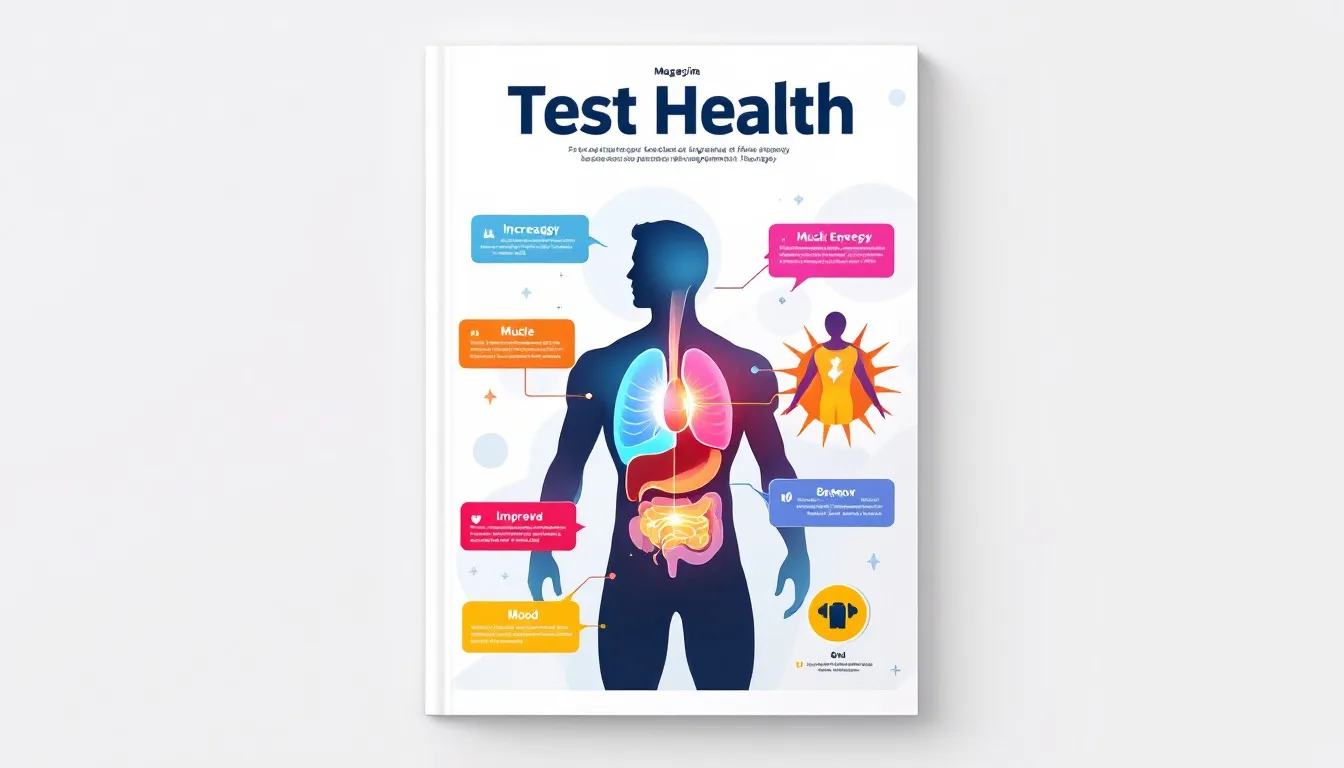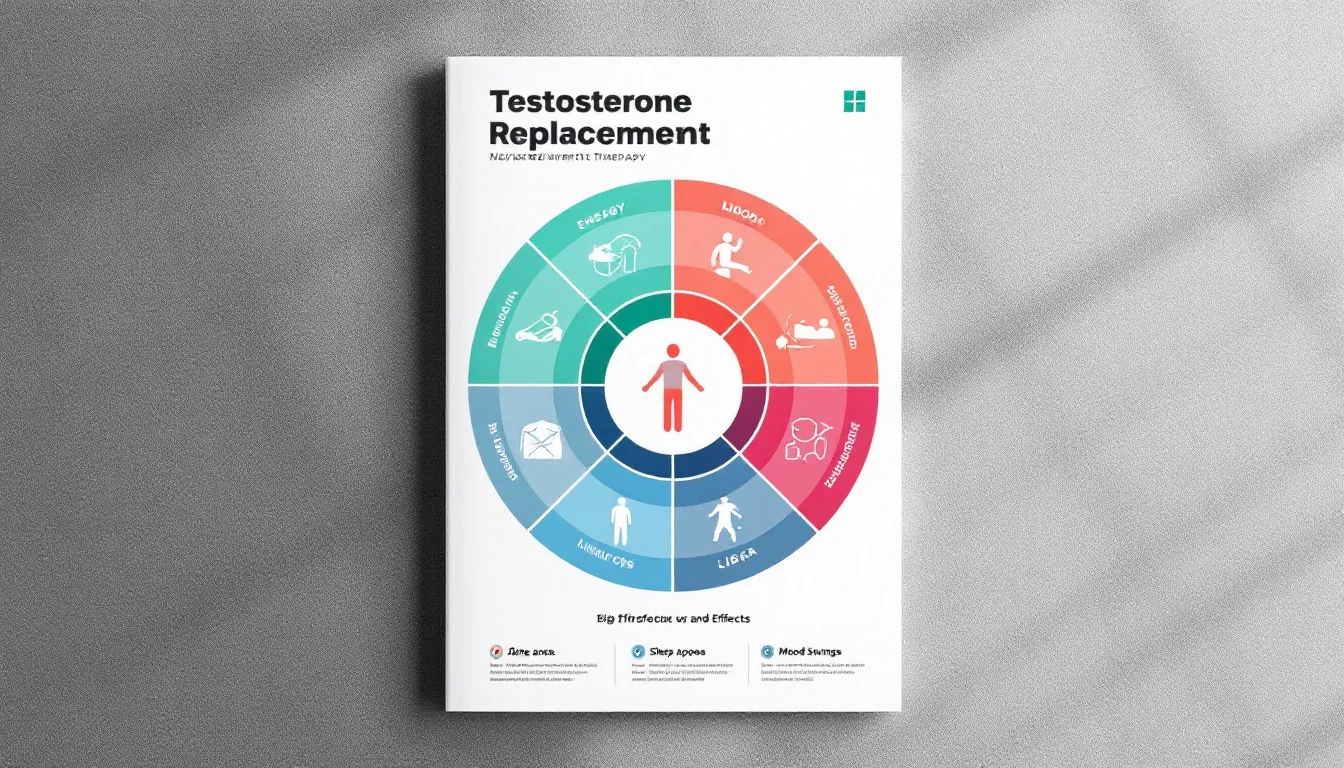Considering TRT Therapy? Weighing the Benefits and Risks
Testosterone Replacement Therapy (TRT therapy) is a treatment for men with low testosterone levels. It aims to improve symptoms like low libido, fatigue, and muscle loss. This article will explore what TRT therapy involves, its benefits, and potential risks, helping you decide if it’s the right choice for you.
Key Takeaways
- Testosterone Replacement Therapy (TRT) is designed to alleviate symptoms of low testosterone, particularly in men with hypogonadism, and is available in various forms including injections, patches, gels, and pellets.
- While TRT offers benefits such as increased libido, energy, and muscle mass, it also carries risks like cardiovascular issues, prostate health concerns, and possible side effects that require careful monitoring.
- Natural alternatives to enhance testosterone levels include lifestyle changes such as exercise, sleep optimization, stress management, and specific supplements, which can be discussed with a healthcare provider as an option before considering TRT.
Understanding Testosterone Replacement Therapy (TRT)

Testosterone Replacement Therapy (TRT) is a medical treatment designed for men experiencing symptomatic hypogonadism, a condition where the body doesn’t produce enough testosterone. Testosterone is a crucial hormone that regulates libido, sexual function, muscle mass, bone density, fat distribution, mental wellbeing, and hormone replacement therapy. Consulting a healthcare provider helps you make an informed decision about TRT options.
TRT is more than just boosting testosterone levels; it addresses symptoms associated with low testosterone. TRT comes in various forms, including:
- Injections
- Patches
- Gels
- Pellets Each form has its own set of benefits and considerations.
What is TRT?
TRT supplements the body with testosterone to alleviate low testosterone symptoms. This can be achieved through various methods such as:
- Injections
- Patches
- Gels
- Pellets implanted under the skin
Each method has its own advantages, and the choice often depends on personal preference and medical advice.
The goal of TRT is to restore testosterone levels to a normal range, thereby improving physical health, sexual function, and overall quality of life. TRT is typically prescribed for men diagnosed with hypogonadism, a condition where the body cannot produce adequate testosterone.
How does TRT work?
TRT supplements the body with testosterone, addressing the deficiency and alleviating related symptoms. The supplemented testosterone helps regulate various bodily functions, including libido, muscle mass, and bone density, effectively improving the overall quality of life for men with low testosterone.
Recognizing Symptoms of Low Testosterone

Identifying symptoms of low testosterone helps determine if TRT is right for you. Nearly 40% of men over 45 and over 50% of men over 75 experience low testosterone, making it a common condition among aging males. Symptoms can include:
- Decline in sexual drive and function
- Decreased muscle mass
- Weight gain
- Mood changes
- Fatigue
- Osteoporosis
To diagnose hypogonadism, both low testosterone results and specific clinical symptoms must be present, including considerations for androgen deficiency syndromes. This dual approach ensures that the treatment is appropriate and tailored to individual needs. Discussing symptoms with your healthcare provider helps determine the best course of action.
Physical symptoms
Physical symptoms of low testosterone include loss of muscle mass, increased body fat, and a general decline in physical performance. Testosterone levels typically decrease by about 1% yearly after the age of 30, contributing to these changes. By age 60, the decline can be significant, worsening muscle loss and other physical symptoms.
Identifying these physical exam changes can help recognize low testosterone as a potential issue.
Sexual symptoms
Sexual symptoms are often the most distressing indicators of low testosterone. Common issues include erectile dysfunction, sexual dysfunction, and a decreased libido. These symptoms not only affect physical health but can also impact mental wellbeing.
Testosterone therapy has the potential to improve sexual function, though the extent of improvement varies among individuals through testosterone treatment.
Mental health symptoms
Mental health symptoms associated with low testosterone include fatigue, mood changes, and difficulty concentrating. Low testosterone levels are also linked to depressive symptoms, which can negatively affect overall mood, cognitive performance, and low t.
Improving these mental health symptoms can enhance the overall quality of life.
Causes of Low Testosterone
Understanding the causes of low testosterone can help in determining the most appropriate treatment options. Low testosterone levels can stem from medical conditions such as male hypogonadism and obesity, which increase the likelihood of testosterone deficiency. Factors such as obesity, poor diet, lack of exercise, and chronic stress can also negatively affect testosterone levels.
Making lifestyle changes, including improving diet, increasing physical activity, and managing stress levels, can help enhance testosterone production naturally. However, for some, medical intervention through TRT may be necessary to address the symptoms effectively.
Age-related decline
Testosterone levels naturally decline with age, typically by about 1% a year after age 30 or 40. It is important to differentiate whether low testosterone levels in older men are due to normal levels of aging or underlying medical conditions.
Genetics also play a role in influencing how rapidly testosterone levels decline as men age.
Medical conditions
Medical conditions that can lead to low testosterone levels include:
- Hypogonadism: the inability to produce normal amounts of testosterone due to issues with the testicles or pituitary gland
- Medication side effects
- Obstructive sleep apnea
- Thyroid problems
- Diabetes
- Depression
Lifestyle factors
Lifestyle factors such as obesity, poor diet, lack of exercise, and chronic stress can significantly impact testosterone levels. Low testosterone slows metabolism and increases fat storage, while also affecting sleep and overall metabolic syndrome.
Benefits of Testosterone Replacement Therapy

Testosterone Replacement Therapy (TRT) offers several potential benefits for men experiencing low testosterone, including:
- Improvements in libido
- Increased energy levels
- Enhanced muscle mass
- Better cognitive function
- Improved bone density
Aging men often see TRT as a promising way for the aging male to feel younger and more vigorous.
However, it’s important to understand that the health benefits associated with TRT are still not fully clear, and ongoing research is important. Misconceptions surrounding testosterone therapy may lead individuals to see it as the ultimate solution for aging-related issues.
Improved sexual function
TRT can significantly enhance libido and improve erectile function by restoring normal testosterone levels. While testosterone can boost sexual desire, the extent of improvement in sexual function varies among individuals.
Enhancing sexual function through TRT can lead to a better quality of life and improved relationships.
Increased energy levels
Low testosterone is associated with reduced energy levels and fatigue. TRT has been reported by many patients to enhance their energy level and overall vitality. TRT can significantly boost stamina and reduce fatigue by improving red blood cell production and oxygen delivery to tissues.
Enhanced physical health
Testosterone plays a crucial role in maintaining physical health, impacting muscle mass, strength, and overall body composition. TRT has been associated with increases in muscle mass and improvements in body composition, contributing to better physical performance. Additionally, testosterone directly influences these factors.
Low testosterone can lead to decreased strength and endurance, making TRT a valuable treatment option for enhancing physical health.
Risks and Side Effects of TRT

While TRT offers several benefits, it’s essential to consider the potential risks and side effects associated with the therapy. These include prostate cancer, benign prostatic hyperplasia (BPH), and polycythemia. Understand the lack of long-term data and assess any adverse effects before starting TRT.
Testosterone therapy can also lead to high red blood cell counts, increasing the risk of clotting complications. Obesity and diabetes can complicate TRT, so weigh the benefits and risks carefully.
Cardiovascular risks
TRT can stimulate excessive red blood cell production, leading to a high risk of blood clots. Increased vascular events like stroke and myocardial infarction can be a consequence of polycythemia related to cardiovascular disease and TRT.
Men with limited cardiovascular risk capacity should be cautious, as there is potential for edema when prescribing TRT.
Prostate health
Despite concerns, no association has been found between testosterone therapy and an increased risk of prostate cancer. The incidence of prostate cancer in men on testosterone therapy is similar to those not on therapy.
TRT does not worsen lower urinary tract symptoms (LUTS) in men with benign prostatic hyperplasia (BPH) and may even improve LUTS after one year of therapy, despite concerns about prostate enlargement.
Other side effects
Other side effects of TRT can include acne, gynecomastia (breast enlargement), decreased fertility, and dependency on the therapy for maintaining normal hormone levels. Immediate side effects can also involve disturbed breathing during sleep and swollen or tender breasts in various body parts.
Regular monitoring can help in managing these side effects and adjusting the treatment as necessary.
Monitoring and Safety Considerations
Monitoring and safety considerations are key aspects of TRT. Regular monitoring during TRT helps assess testosterone levels and identify potential adverse effects. Follow-up appointments may involve regular monitoring of testosterone levels and adjustment of therapy as needed.
The initial consultation usually involves:
- A thorough evaluation of symptoms and medical history
- Discussion of concerns such as the potential for worsening sleep apnea
- Discussion of the development of acne or other skin reactions with a healthcare provider.
Blood tests
Blood tests are essential for monitoring TRT. Healthcare providers recommend regular monitoring after starting TRT to:
- Ensure safe and beneficial testosterone levels
- Keep testosterone levels within a safe range
- Detect conditions such as polycythemia, which can occur during a blood test for TRT
Regular check-ups
Regular check-ups help catch negative reactions to TRT early and make timely treatment changes. Ongoing consultations help detect adverse effects of TRT early.
Annual evaluations are recommended to assess the patient’s response to treatment and to check for any adverse effects that may arise.
Adjusting treatment
Adjust treatment plans based on individual responses and observed side effects. Modify the treatment plan based on the patient’s response and side effects.
Regular monitoring and adjustments ensure the effectiveness and safety of TRT.
Natural Alternatives to Boost Testosterone

Those hesitant about TRT can consider natural alternatives to boost testosterone levels. These include lifestyle changes, sleep optimization, and stress management. Obesity, excessive alcohol intake, and lack of physical activity significantly contribute to low testosterone levels in men.
Regular physical activity, optimizing sleep, and managing stress can significantly impact testosterone production. By making these lifestyle changes, men can naturally enhance their testosterone levels and overall health.
Lifestyle changes
Lifestyle changes such as regular aerobic and resistance exercise have been shown to elevate testosterone production. Maintaining a healthy weight is important, as excess fat can cause hormone imbalances.
Adequate sleep is important, as most testosterone is produced during deep sleep.
Supplements
Supplements like vitamin D and zinc have been linked to increased testosterone levels and bioavailable testosterone. Zinc and DHEA testosterone supplements can support testosterone levels when dietary intake is insufficient.
Quercetin and grape seed extract may provide additional benefits in regulating testosterone.
Stress management
Stress-reduction techniques can help maintain healthy testosterone levels. Mindfulness, meditation, and yoga can lower stress levels and potentially support healthy testosterone production.
Talking to Your Doctor About TRT
Discussing TRT with your doctor is a crucial step in understanding whether this treatment is right for you. If no medical condition is found, doctors may suggest natural ways to boost testosterone, like weight loss and resistance exercise. Regular exercise, adequate sleep, stress management, a nutrient-rich diet, and weight loss are recommended to boost testosterone production.
Being well-prepared for your appointment, understanding the assessment process, and knowing what to expect during treatment can help in making an informed decision about TRT.
Preparing for the appointment
Provide your doctor with a comprehensive overview of your health history, including:
- Any symptoms related to low testosterone
- Any medical conditions
- Medications you are taking
- Lifestyle factors that might influence testosterone levels Be prepared to discuss these points during your appointment.
Ask your doctor about the potential benefits and risks of TRT, as well as what to expect during treatment.
Assessing eligibility
Assessing eligibility for TRT involves evaluating lifestyle responses and laboratory results from multiple tests. TRT is appropriate when patients demonstrate consistent low testosterone symptoms and fail to respond to non-medical interventions.
Testosterone levels are measured at least twice before recommending therapy to ensure an accurate diagnosis of testosterone level.
Understanding the process
Discuss concerns, symptoms, and treatment options with your healthcare provider during the initial consultation to understand the TRT process. Prepare for the appointment by gathering relevant medical history and creating a list of questions for the doctor.
Regular monitoring through blood tests and consistent medical check-ups ensure the effectiveness and safety of TRT.
Summary
Testosterone Replacement Therapy (TRT) can offer significant benefits for men experiencing low testosterone, but it’s essential to weigh these benefits against the potential risks and side effects. Recognizing the symptoms of low testosterone, understanding the causes, and exploring both medical and natural treatment options can help in making an informed decision.
Consulting with a healthcare provider, undergoing regular monitoring, and being open to adjusting treatment plans are crucial steps in ensuring the effectiveness and safety of TRT. By taking a comprehensive approach, you can improve your overall quality of life and wellbeing.
Frequently Asked Questions
What is Testosterone Replacement Therapy (TRT)?
Testosterone Replacement Therapy (TRT) is a medical treatment for men with low testosterone levels due to hypogonadism, designed to restore hormone levels, enhance physical health, sexual function, and improve overall quality of life. Implementing TRT can lead to significant benefits for those affected by this condition.
What are the common symptoms of low testosterone?
Common symptoms of low testosterone are reduced sexual drive and function, decreased muscle mass, weight gain, mood swings, fatigue, and osteoporosis. Identifying these signs is essential for considering potential treatment options like TRT.
What are the potential risks of TRT?
The potential risks of testosterone replacement therapy (TRT) include prostate cancer, cardiovascular issues like heart attack and stroke, and dependence on the therapy for hormonal balance. It is crucial to weigh these risks against the benefits before initiating treatment.
How is eligibility for TRT assessed?
Eligibility for TRT is determined by evaluating consistent symptoms of low testosterone, lifestyle factors, and laboratory results from multiple tests, particularly noting a lack of response to non-medical interventions. This comprehensive assessment ensures appropriate candidates are selected for treatment.
Are there natural alternatives to boost testosterone levels?
Yes, natural alternatives to boost testosterone levels involve making lifestyle changes such as exercising regularly, maintaining a healthy weight, optimizing sleep, and managing stress, along with potentially using supplements like vitamin D and zinc for dietary support.